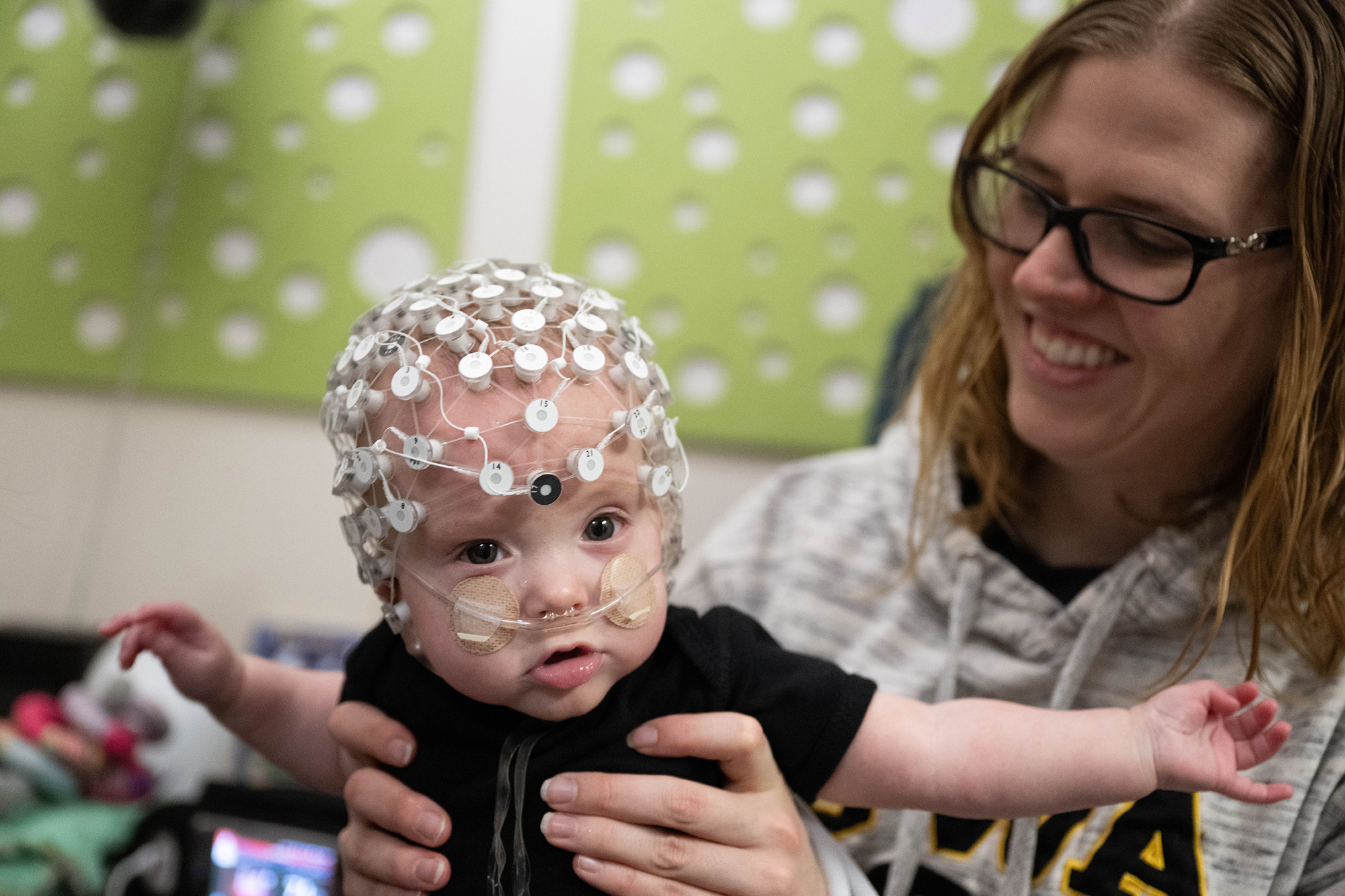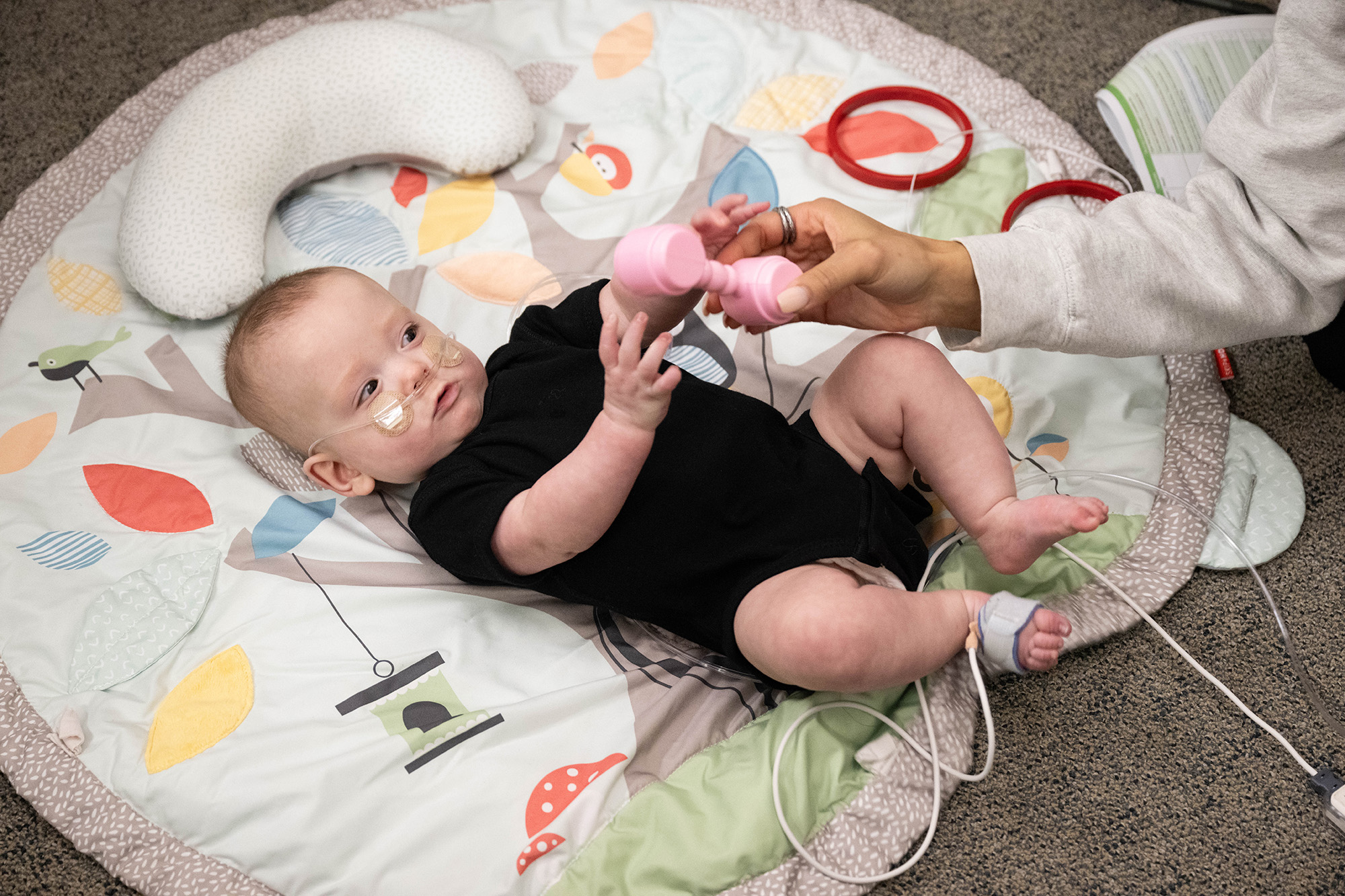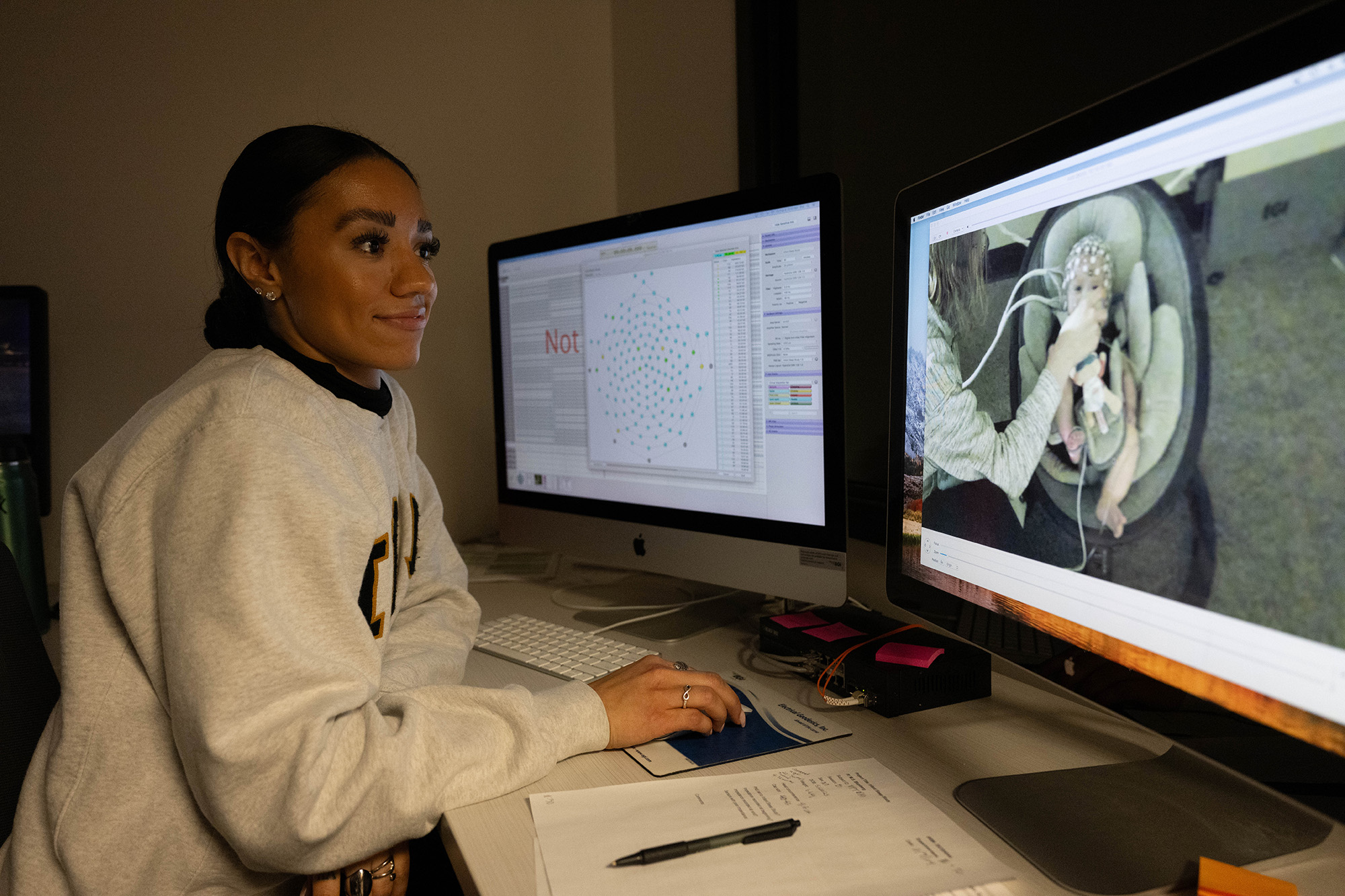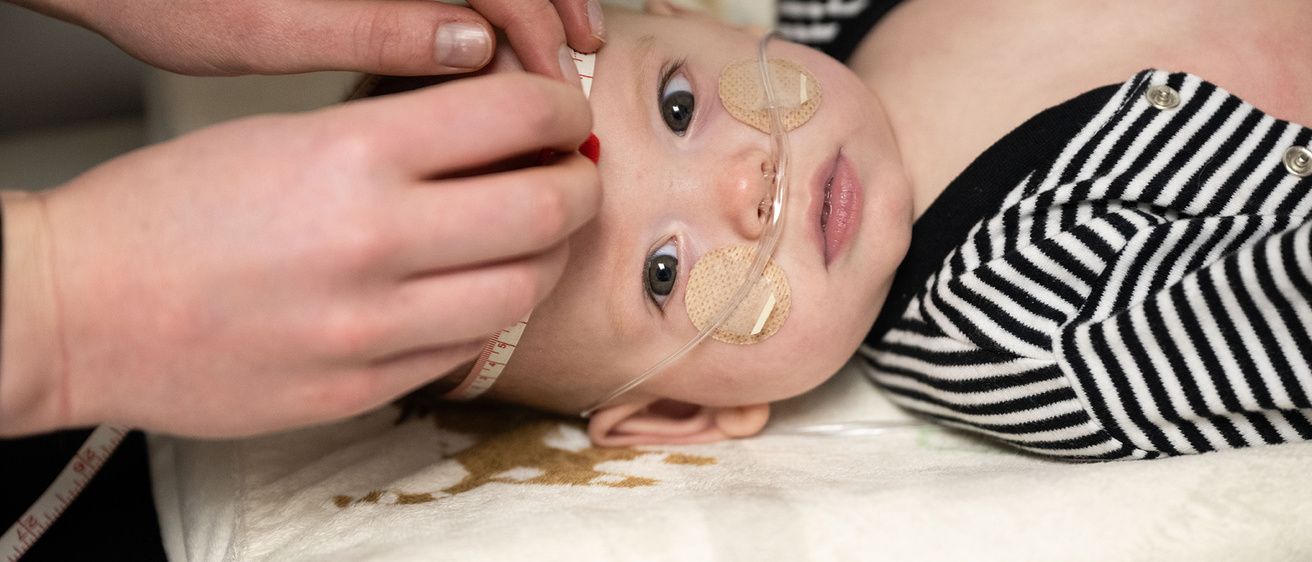Researchers at the University of Iowa are studying the sleep of premature babies to get the earliest look to date into how the twitches that occur during REM sleep shape the nascent communication between brain and body.
Story: Richad C. Lewis
Photography: Tim Schoon
Videography: Matt Jansen
Published: April 1, 2025
William Kline was not interested in falling asleep.
Instead, the 4-month-old was lying belly down on his baby blanket in the Sleep and Behavioral Development Lab on the University of Iowa campus, grasping a red rattle as he excitedly smacked his legs together as if clapping with glee.
“He took a power nap in the car,” his mother, Lacey Kline, said, with a hint of exasperation.
William and his sleep are central to a five-year, $3.1 million research study funded by the National Institute of Child Health and Human Development and led by Mark Blumberg, University of Iowa Distinguished Chair in the Department of Psychological and Brain Sciences.
Blumberg and his team aim to learn more about how sleep — and twitches that occur during a key phase of sleep — influences brain development in babies. The researchers have partnered with neonatologists, pediatricians, and research nurses in the Neonatal Intensive Care Unit (NICU) at UI Health Care Stead Family Children’s Hospital, recruiting hundreds of preterm infants whose sleep and twitches are being observed and recorded while they are in the hospital.
What makes William special is he was born prematurely, offering a window into how the brain functions during sleep in this very early period of development. The study aims to compare premature infants’ sleep, their twitches, and brain activity to that of full-term infants.
“Everyone is familiar with babies kicking while in the womb,” Blumberg says. “Most of the time, those kicks are limb twitches during rapid eye movement (REM) sleep. But without imaging or direct observation, we can’t know for certain how much movement is occurring or which parts of the body move the most. So, with these premature infants, we have the opportunity to observe exactly how much twitching occurs in the face, eyes, limbs, fingers, and toes.”
Why the research matters
Infants born prematurely are at increased risk for disorders, such as autism and cerebral palsy, that often are marked by severe deficits in motor behavior.
“We’re focusing on sleep because it’s the most prominent state of infancy, and twitches are the most prominent behavior, and so we are hoping to gain new insights into neurodevelopmental risk, especially for babies born prematurely,” says Greta Sokoloff, research scientist in Mark Blumberg’s lab who oversees the NIH study.
Why that matters — and a central goal of the study — is that infants born prematurely are at increased risk for disorders, such as autism and cerebral palsy, that often are marked by severe deficits in motor behavior.
“We’re focusing on sleep because it’s the most prominent state of infancy, and twitches are the most prominent behavior, and so we are hoping to gain new insights into neurodevelopmental risk, especially for babies born prematurely,” says Greta Sokoloff, research scientist in Blumberg’s lab who oversees the NIH study.
The research builds on findings by Blumberg’s team about the importance of twitches to the burgeoning communications infrastructure between the brain and the body in human infants. What the Iowa researchers have learned in previous work, by recording sleeping rats as they twitch, is the critical role played by these seemingly involuntary bursts of movement for the development of the sensorimotor system, by which the brain senses and catalogs the movements of limbs and other parts of the body.
“You can think of twitches as the body’s way of discovering itself,” Blumberg explains. “When you’re a newborn infant, you don’t have much of a sense of what kind of a body you have or how it’s changing as you grow. Every animal needs to figure that out. From very early on, twitches help infants figure out the body that they have, and we believe that that process of self-discovery helps to explain why sleep and twitching are so prominent in early life.”
A lot of this information sharing, as it turns out, happens during sleep. And newborn infants sleep a lot — about 16 hours each day, divided evenly between REM and non-REM sleep. Babies in utero appear to sleep for even more hours each day.
Findings from Blumberg’s lab, in rats and humans, have shifted the focus of REM sleep away from dreaming. After all, as Blumberg mused more than two decades ago when watching newborn rats in REM sleep: What do these pups, with their undeveloped brains, sealed-shut eyes, and limited experience with the world, possibly dream about?
So, if the thousands upon thousands of twitches of eyes, paws, fingers, toes, or whiskers are no longer tied to dreams, then they must indicate something else going on.
“If you don’t think the conventional wisdom smells right, then you look for alternative explanations,” Blumberg says. “The fact is we didn’t know very much about what was going on during sleep in early infancy. So, we started developing methods to do the hard work. And a whole new world opened up to us.”
• • • • •

William Kline, seen here with his mother, Lacey, wears a net of 128 high-density electrodes over his head. The electrode cap will measure William’s bursts of brain activity while asleep. Later, student researchers in the lab will score each of the 2,000 or so facial and limb twitches William is expected to make during the two hours he is asleep, which will be analyzed along with his brain activity to assess their connection.
“I want every baby to be happy and healthy. Anything that might be different about William that could help lead to advances in the care and knowledge of premature babies or babies in general is valuable.”
William Kline was born May 26, 2023, at 23 weeks, weighing just 1.7 pounds. He couldn’t breathe or eat on his own. He was in intensive care for 135 days.
“I’m watching this very fragile baby, and at first I was terrified,” says Lacey Kline, who lives in South Amana, Iowa, “but he kept getting bigger and stronger every day, and I became more and more confident everything will be OK.”
While at Stead Family Children’s Hospital, Kline was asked by research nurses in the NICU if she wanted to enroll her son in the NIH study led by Blumberg. Kline, who herself was born prematurely and whose daughter also was born a few weeks early, quickly agreed.
“I want every baby to be happy and healthy,” says Kline, who has an MBA from Iowa. “Anything that might be different about William that could help lead to advances in the care and knowledge of premature babies or babies in general is valuable.”
The partnership between Blumberg’s lab, the research nurses in the NICU, and clinicians in the Department of Pediatrics is integral to the study’s success.
Tarah Colaizy, professor in pediatrics-neonatology and a study co-investigator, recalls when Blumberg and Sokoloff approached her and others about their idea. To her, it fit seamlessly with UI Health Care’s goal to provide the best care for everyone.
“We’re global leaders in premature infant births success, and we want to keep getting better and better,” Colaizy says. “To do that, we need to know the most we can about our patients, including premature infants, of course.”
When a premature baby has been enrolled, the NICU research nurses collaborate with the mother to determine the best time to study the infant. In general, they’ve established that the best time is soon after the baby has been fed and is feeling sleepy. The nurses put the infant in bed and apply four electrodes to the baby’s scalp, “like a sticker,” as Colaizy describes them. The electrodes measure brain activity while the infant is asleep, while an iPhone positioned on a mobile arm at bedside records twitches that occur while the baby is asleep.
“It’s really about making them comfortable and changing their environment as little as possible,” Colaizy adds.
The NICU research team aims to get recordings every two weeks for the time a premature infant is in the hospital. So far, they’ve studied more than 100 infants who were born as early as 21 weeks to 36 weeks. The goal is to enroll nearly 500 by the project’s end.
The number and age range are important for another study goal: understanding the duration and quality of sleep premature infants are getting in the hospital.
Already, the researchers have documented that premature infants sleep less than they would have if still in the womb, supporting previous findings.
“The literature on fetal sleep indicates that babies are not truly awake in utero until after 32 weeks. Many premature infants are being born way before that,” Sokoloff says. “And they’re being exposed to a much different environment than they would be if they had been born full term.”
While the NICU staff makes every effort to optimize sleep for premature babies, these findings can yield improvements.
“It may seem silly that by recording them sleeping, we could help these babies have the best brain development possible,” Colaizy says. “But if there are certain sleeping patterns that are associated with better brain development, and there are things we can do to encourage babies to have those sleep patterns, we want to know that, so we can intervene and help.”
“We already know what full-term infant sleep looks like at these ages, but we want to compare their sleep to that of premature infants to see how it differs,” Sokoloff adds. “And not just the amount of sleep per se, but the organization and timing of sleep, and the occurrence of twitching across age and experience.”
• • • • •

William Kline participates in a behavioral test, which the University of Iowa research team conducts to chart William’s motor-skill development. Combined with the observations of William's sleep in the NICU and in the sleep lab, the tracking of motor skills will inform efforts to associate premature birth with sleep and risk for neurodevelopmental disorders.
Researchers completed five sessions with William Kline while he was in the NICU. Months later, he was returning for a second follow-up session in Blumberg’s sleep lab on the Iowa campus. While he was prematurely born eight months ago, he’s considered as a 4-month-old for research purposes because that is his age if he had been born at full term.
Hailey Long, a research associate in Blumberg’s group who graduated from Iowa in 2019 and earned a master’s degree in physiology from Case Western Reserve University, held a small red hoop attached to a string over William and tempted him to grab it.
“Good job,” Long said when William reached and grasped the toy.
With these behavioral tests, the team charts William’s motor-skill development. Combined with the observations of his sleep in the NICU and in the sleep lab, the tracking of motor skills will inform efforts to associate premature birth with sleep and risk for neurodevelopmental disorders.
Assisting Long that day in the sleep lab was Taylor Christiansen, a second-year graduate student in psychology at Iowa. As Lacey Kline settled into a rocker with a bottle to begin getting William to fall asleep, Christiansen gently draped a net of 128 high-density electrodes over the infant’s head. Much like the electrode stickers applied to premature babies in the NICU, the white electrode cap will measure William’s bursts of brain activity while asleep. Later, student researchers in the lab will score each of the 2,000 or so facial and limb twitches William is expected to make during the two hours he is asleep, which will be analyzed along with his brain activity to assess their connection.
Christiansen was a research assistant at Brown University and contemplating doctoral programs when she heard Blumberg speak in 2022 at a conference of the Sleep Research Society in Charlotte, North Carolina. At the end of his talk, Blumberg mentioned his newest project with premature infants.
“I just thought he was doing the coolest research ever,” says Christiansen, who is from Lyons, Colorado, “so I came here.”
• • • • •

Hailey Long, a research associate in Blumberg’s group who graduated from Iowa in 2019 and earned a master’s degree in physiology from Case Western Reserve University, observes William Kline and his mother on a monitor.
Ever feisty, William Kline was not going to sleep without at least some resistance. In a mostly darkened room, his mother gently rocked him and placed a pacifier in his mouth, as soothing music played. In another room, Christiansen and Long watched Lacey and William on one computer monitor, while on a second, adjacent computer screen, a color-coded diagram showed the working status of each electrode in the cap, to ensure the brain activity would be captured when William fell asleep.
Within minutes, William was dozing off. The researchers entered the room, removed a blanket to expose his arms and legs, and placed a sensor on his stomach that captures his sleep state through his breathing. The only visible feature in the room was a blinking red light from the recording camera.
William slept peacefully. The researchers had another baby to observe, another set of twitches to score, another step toward divining what it all means.
